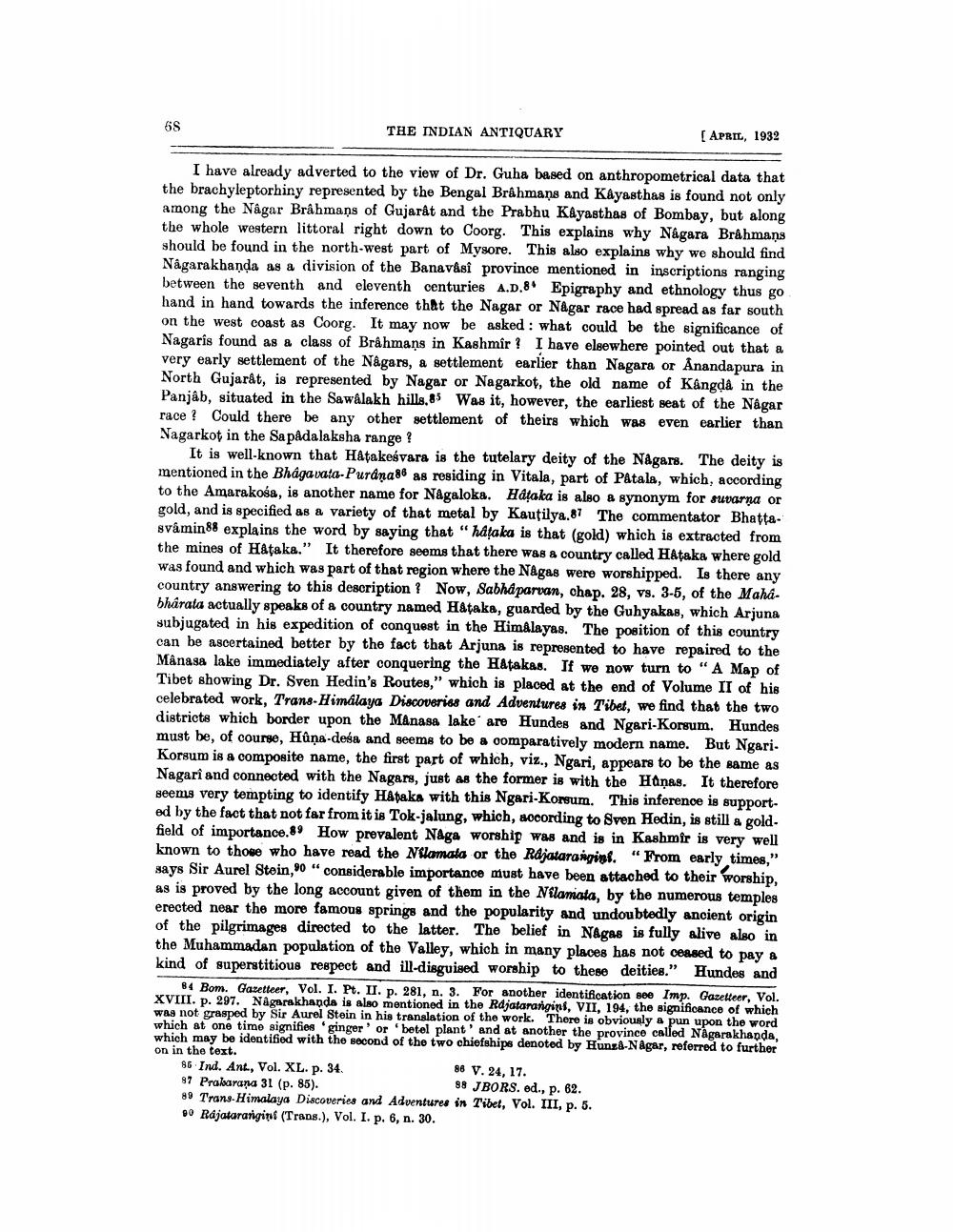________________
68
THE INDIAN ANTIQUARY
[ APRIL, 1932
I have already adverted to the view of Dr. Guha based on anthropometrical data that the brachyleptorhiny represented by the Bengal Brâhmans and Kayasthas is found not only among the Nagar Brahmans of Gujarat and the Prabhu Kayasthas of Bombay, but along the whole western littoral right down to Coorg. This explains why Nagara Brahmans should be found in the north-west part of Mysore. This also explains why we should find Någarakhanda as a division of the Banavâsî province mentioned in inscriptions ranging between the seventh and eleventh centuries A.D.84 Epigraphy and ethnology thus go hand in hand towards the inference that the Nagar or Nagar race had spread as far south on the west coast as Coorg. It may now be asked : what could be the significance of Nagaris found as a class of Brahmans in Kashmir ? I have elsewhere pointed out that a very early settlement of the Nagars, a settlement earlier than Nagara or Anandapura in North Gujarat, is represented by Nagar or Nagarkot, the old name of Kängdå in the Panjab, situated in the Sawalakh hills.85 Was it, however, the earliest seat of the Nagar race ? Could there be any other settlement of theirs which was even earlier than Nagarkot in the Sa padalaksha range?
It is well-known that Hatakeśvara is the tutelary deity of the Nagars. The deity is mentioned in the Bhagavata-Purdna86 as residing in Vitala, part of Patala, which, according to the Amarakosa, is another name for Nagaloka. Hataka is also a synonym for suvarna or gold, and is specified as a variety of that metal by Kautilya.87 The commentator Bhattasvamin88 explains the word by saying that "håțaka is that (gold) which is extracted from the mines of Hataka." It therefore seems that there was a country called Hataka where gold was found and which was part of that region where the N&gas were worshipped. Is there any country answering to this description ? Now, Sabha parvan, chap. 28, vs. 3-5, of the Mahabharata actually speaks of a country named Hataka, guarded by the Guhyakas, which Arjuna subjugated in his expedition of conquest in the Himalayas. The position of this country can be ascertained better by the fact that Arjuna is represented to have repaired to the Mânasa lake immediately after conquering the Hatakas. If we now turn to "A Map of Tibet showing Dr. Sven Hedin's Routes," which is placed at the end of Volume II of his celebrated work, Trans-Himalaya Discoveries and Adventures in Tibet, we find that the two districts which border upon the Månasa lake are Hundes and Ngari-Korsum. Hundes must be, of course, Hûna-deśa and seems to be a comparatively modern name. But Ngari. Korsum is a composite name, the first part of which, viz., Ngari, appears to be the same as Nagari and connected with the Nagars, just as the former is with the Hanas. It therefore seems very tempting to identify HApaka with this Ngari-Konsum. This inferenoe is supported by the fact that not far from it is Tok.jalung, which, according to Sven Hedin, is still a gold. field of importance.99 How prevalent Naga worship was and is in Kashmir is very well known to those who have read the Nflamata or the Rajatarangini. "From early times," says Sir Aurel Stein,"0" considerable importance must have been attached to their worship, as is proved by the long account given of them in the Nilamiata, by the numerous temples erected near the more famous springs and the popularity and undoubtedly ancient origin of the pilgrimages directed to the latter. The belief in Nagas is fully alive also in the Muhammadan population of the Valley, which in many places has not ceased to pay a kind of superstitious respect and ill-disguised worship to these deities.” Hundes and
84 Bom. Gazetteer, Vol. I. Pt. II. p. 281, n. 3. For another identification see Imp. Gazelleer, Vol. XVIII. p. 297. Någarakhanda is also mentioned in the Rdjatarangin, VII, 194, the significance of which was not grasped by Sir Aurel Stein in his translation of the work. There is obviously a pun upon the word which at one timo signifies 'ginger' or 'betel plant and at another the provinco called Någarakhanda, which may be identified with the second of the two chiefships denoted by HungaNagar, referred to further on in the text. 86 Ind. Ant., Vol. XL. p. 34.
86 V. 24, 17. 87 Prakarana 31 (p. 85).
98 JBORS. ed., p. 62. 89 Trans Himalaya Discoveries and Adventures in Tibet, Vol. III, p. 5.
Rajatarangin (Trans.), Vol. I. p. 6, n. 30.




